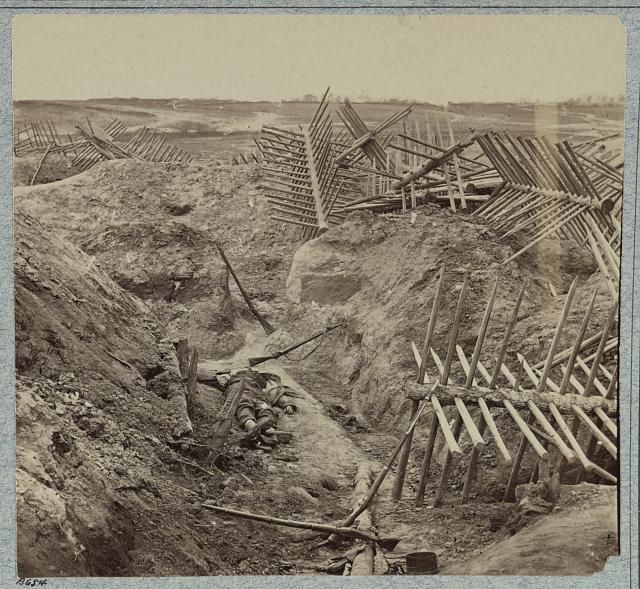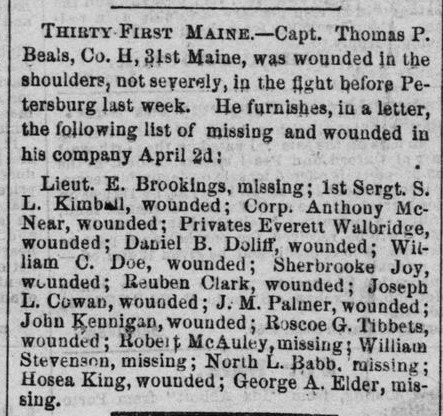Ending The War: A Union Prisoner on Lee’s Retreat
First Lieutenant Elias Brookings, Jr., 31st Maine Infantry, found himself in an unusual situation at the end of the war. His unit had been overrun during the frantic fighting around Fort Mahone on April 2, 1865. The Federals ultimately won the battle and forced the Confederates to evacuate not just their line, but Petersburg and Richmond as well. Brookings, however, would accompany Lee’s retreat westward as a prisoner of war.
Elias was born on January 1, 1836 in Woolwich, Maine. He graduated from Waterville College (modern-day Colby College) in 1862 and served as principal of Cherryfield Academy. He married Frances Redman on February 24, 1864. A month and a half later he responded to a call for volunteers and on April 9th he mustered into service as first lieutenant of Company H, 31st Maine Infantry.
The regiment departed for Virginia on April 18th and was attached to the 2nd Brigade, 2nd Division of Ambrose Burnside’s 9th Corps. They were immediately thrown into combat and saw heavy fighting throughout the Overland Campaign. Brookings suffered a minor wound at Cold Harbor on June 6th, but quickly returned to his company at Petersburg. There, he participated in the doomed assault at the Crater on July 30th and fought again at Peebles Farm in late September. After that offensive, the unit garrisoned Fort Fisher as it was built before transferring east to Fort Davis. There, heavy casualties between the pair forced its sister regiment, the 32nd Maine Infantry, to fold into its ranks.
The 9th Corps remained stationed along Petersburg’s eastern front during the opening days of Ulysses S. Grant’s final offensive against Petersburg in late March 1865. Major General John G. Parke, who replaced Burnside after the Crater, had standing orders to launch an assault should intel suggest the enemy had weakened their lines in his front as a reaction to Grant’s maneuvering. Though no units from the Confederate Second Corps departed during this time, Parke received orders late on April 1 to carry out his attack.
Parke identified the point where the Jerusalem Plank Road crossed through the Confederate entrenchments for his assault, which was to take place at 4 a.m. on April 2nd. Four brigades centered along the avenue under the cover of darkness, each having its regiments stack up behind one another in a compact column. Simon Griffin’s brigade, to which the 31st Maine belonged, lined up just to the left of the plank road.

Each brigade placed storming parties in their front to clear the obstructions between the lines and to subdue the Confederate pickets. Griffin selected Brookings’s company along with Companies C and L for the perilous task. Captain Thomas P. Beals, who commanded the detachment, recalled:
General Griffin rode down to the head of his column, where the storming party was and gave to me very precise orders, the gist of which was, that at the signal, which would be a low call passed along the line, “Four o’clock and all is well,” I should march forward with the storming party in column of fours gaining to the right, until we struck the Jerusalem Road, and then to move along that road until we reached the enemy’s works. Our duties would be then to assist the pioneers in removing the chevaux-de-frise in front of the Confederate works and to lead the main column over them.
I do not think there was any flinching in our small portion of this column of attack, but we had often seen by daylight what we were about to encounter in a physical manner, and there can be no doubt that few of us expected to emerge alive from this affair; for one, I did not.
Despite these concerns, Beals’s men easily accomplished the first component of their mission. “The air is alive with shot and shell,” recalled Lieutenant Brookings. Despite the severity of the gunfire, “The troops move grandly forward at the word of command. The enemy’s picket line is reached and its garrison became prisoners.” Sergeant Julius Julius D. Rhodes likewise claimed, “When we reached the fort the chevaux de frise was unbroken, but in less time than I can write it we were through the chevaux de frise, and the fort was ours.”

Both armies acknowledged that the outer works stood vulnerable to capture due to the close proximity of the opposing fortifications on the eastern front. Therefore they had developed a sort of defense-in-depth, and relied on secondary entrenchments and reactive counterattacks to stabilize the lines. These multiple rows of trenches bogged down the 9th Corps attack that morning. Brookings continued his recollection:
But here the first line of battle halts. The embankment of earth thrown up for the protection of the picket seemed at one time the limit of our advance. The second and third lines mingle with the first. There is more or less confusion. The old order, “for-ward!” “for-ward!” is not heeded. Swords are freely used to urge the men forward. It is useless to think of reforming.
At length advancing under a galling fire the enemy’s line is taken. A fort is entered. For a moment the troops had supposed themselves in possession of the main line, but a glance showed that the garrison of this fort had retreated to a stronger line in the rear. A brisk fire is kept up toward the enemy without much gain. Some, considering it useless for the present force to advance, returned to our lines.
Though Parke’s men successfully overran the outer works from Battery 25 to Battery 29 (Fort Mahone), organized bands of Union soldiers could not penetrate further into the cobweb of Confederate fortifications beyond the main lines. As the 9th Corps clung to the ground they had gained, John Gordon’s Second Corps prepared for a counterattack. Advanced parties, like Beals’s detachment, stood first in their path. Brookings recalled:
A messenger, being sent to the rear to give information of our situation, soon returned with the order to “hold on.” Our ammunition was about exhausted. The confederates seeing this charge upon us and we are prisoners of war until Gen. Lee’s surrender.
Unfortunately the reminiscence ends at this point. Parke organized another attack and recaptured the ground initially taken that morning. Meanwhile, the 6th Corps had advanced southwest of Petersburg at 4:40 a.m. and decisively broke through the Confederate Third Corps lines. They rolled southward as the 24th Corps expanded the breach to the outskirts of Petersburg. Robert E. Lee issued evacuation orders and the long retreat to Appomattox began.

Brookings accompanied the Army of Northern Virginia for the next seven days as a prisoner of war, but I have not been able to identify anything he wrote about the experience. How were the men guarded? Did they consider escaping during the frantic retreat or were they confident that they just needed to bide their time before the eventual surrender? Did they receive any food from their captors who were struggling to find supplies of their own during the retreat? I wish he had shared more about this experience and I do believe there is a manuscript or article by Brookings out there that delves further into his unique story. He apparently did speak freely about the matter. A postwar article states:
While incarcerated he saw the inside of the confederacy. What impressed him the most was the implicit confidence the southerners imposed in Gen. Lee, their commander. He could not help seeing the destitute condition of the confederate army which was held intact solely by the devotion of the men to their leader.

Lee’s surrender at Appomattox allowed Brookings and his fellow prisoners to rejoin their units. He returned to teaching in Cherryfield after the 31st Maine mustered out of service on July 15th. In 1869 he moved to Springfield, Massachusetts and taught at the Central Street Grammar School until 1906, leading frequent excursions to Europe for both students and travelers. Elias Brookings died on August 3, 1906, and is buried in Springfield Cemetery. His obituary notes:
Gentle consideration and wise regard for individualities came in play all through his intercourse with his fellows,–children or older folks. He has a serious integrity of life,–not much affected by philosophic or other speculation, but sincere, human, and humane. No lessons other than those of kindness and honor ever were derived from Elias Brookings. His own story of his war recollections expresses the direct simplicity of his nature.
Hopefully more of his story can be discovered.
Sources:
Beals, Thomas P., “In a Charge Near Fort Hell, Petersburg, April 2, 1865,” War Papers Read Before the Commandery of the State of Maine, Military Order of the Loyal Legion of the United States, Volume 2, Portland, ME: Lefavor-Tower Company, 1902, 105-115.
Brookings, Elias, “War Memories: The Siege of Petersburg,” Springfield Republican, January 31, 1887.
“Death of Elias Brookings,” Springfield Republican, August 4, 1906.
“Fifty Years a Teacher: Record of Schoolmaster Elias Brookings,” Boston Globe, January 7, 1906.
Rhodes, Julius D., “Fort Mahone: The 31st Me. in the Desperate Charge,” National Tribune, August 18, 1887.

I’ve always wondered about the stories of those 2000+ Union prisoners who made the march to Appomattox with the Army of Northern Virginia. I hope you can find more . . .
Great article, very interesting. I enjoyed the map and the photograph of the trench, also. The guns in the picture look like that they were carefully placed like props. That makes me wonder about the “body”.
I was a student of Elias Brookings elementary school in Spfld. Mass. and always wondered who Elias Brookings was, thanks for this article it fills gaps.